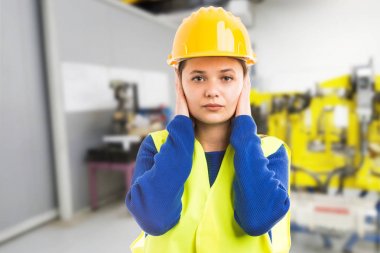The modern industrialized world has exposed millions of workers to hazardous noise levels in their places of work. This has resulted in a risk of developing occupational hearing loss.
Occupational hearing loss is a widespread but preventable health issue that significantly affects the productivity and life quality of a worker.
Below, you will find the causes and consequences of occupational hearing loss, the industries most affected, and also important workplace safety measures that can protect a worker’s hearing health.
What is Occupational Hearing Loss?
Occupational hearing loss is a type of sensorineural hearing loss caused by repeated or prolonged exposure to high levels of noise in the workplace. Constant exposure to hazardous noise harms the delicate hair cells in the inner ear. This leads to permanent hearing impairment. Usually, this damage is gradual, and the individual might not notice the loss immediately, till it becomes more severe.
Industries Most Affected by Occupational Hearing Loss
Several industries expose workers to high noise levels, which places them at risk of occupational hearing loss. Some of these industries include:
- Manufacturing: Industrial facilities and factories usually operate heavy equipment and machinery that generate substantial noise levels.
- Construction: Construction sites are well known for their dynamic and loud environments as several machinery and tools add to the noise pollution.
- Mining: When mining, it involves the use of powerful crushers, excavators, and drills. This results in significant noise exposure for the workers.
- Agriculture: The use of farming tools like grain dryers, chainsaws, and tractors during farming activities usually adds to increased noise levels.
- Transportation: Workers in railway yards, shipyards, and airports are exposed to noise from ground support equipment, vehicles, and engines.
Causes and Consequences of Occupational Hearing Loss:
The key cause of occupational hearing loss is constant exposure to hazardous noise over a long period. Several factors usually contribute to this development. Some of them are:
- Excessive noise exposure: This is the primary risk factor contributing to occupational hearing loss. Industries such as transportation, mining, construction, and manufacturing, usually generate substantial noise levels from tools, equipment, and machinery, putting workers at risk.
- Type of noise: The type of noise also affects the gravity of hearing damage. Continuous noise like impulsive noise, hum of machinery, and blast from powerful tools usually adds to hearing loss.
- Duration of exposure: Workers have a high risk of hearing damage if they are exposed to hazardous noise over an extended period. This prolonged exposure especially without the right hearing protection increases the chance of developing occupational hearing loss.
- Individual susceptibility: Certain individuals might be more genetically inclined to hearing damage. This makes them more at risk of noise exposure effects.
- Absence of hearing protection: When individuals don’t use the right hearing protection like earmuffs or earplugs in noisy environments, it can substantially increase the risk of hearing loss.
Consequences of Occupational Hearing Loss
Occupational hearing loss consequences can be far-reaching and profound. Workers affected by hearing impairment might experience:
- Communication difficulties: Hearing impairment usually impedes effective communication in the workplace. This would result in misunderstandings and decreased productivity.
- Reduced job performance: Workers with hearing impairments might struggle in performing their tasks efficiently. This would result in decreased job satisfaction and their overall performance.
- Increased safety risks: Workers in industries where safety is foremost can have their ability to communicate important information or detect warning compromised. This can result in injuries and accidents.
- Social isolation: Hearing loss can cause withdrawal and social isolation. Affected people might find it hard to engage in social interactions and conversations.
- Emotional distress: Hearing loss can result in depression, anxiety, and stress, especially when it affects job prospects and personal relationships.
Workplace Safety Measures for Hearing Health

The application of effective safety measures can crucially reduce the risk of occupational hearing impairment and create not only a productive work environment but also a safer one. Some strategies to employ include:
- Regular hearing screenings: Regular hearing screenings are essential for maintaining optimal hearing health. These screenings encompass painless and simple tests that assess the individual’s hearing sensitivity and also find out early signs of hearing loss. For instance, a company situated in Toronto, Canada can seek help from Toronto Hearing Consultants to conduct regular hearing assessments. This helps in detecting symptoms early and allows prompt intervention and preventive measures. The early identification of problems helps individuals get the right medical care, and timely treatment and use necessary strategies like protective measures for hearing aids and improving their overall life quality.
- Noise assessment: Conducting regular noise assessments in the workplace helps in identifying areas with significant noise levels. It can involve the use of dosimeters or sound level meters to monitor and measure noise exposure.
- Engineering controls: It is also vital to implement engineering controls in reducing noise levels at the source where possible. This might involve replacing or modifying noisy machinery, maintaining equipment to reduce noise emissions, and using sound enclosures and barriers.
- Administrative controls: Organizations can apply administrative controls to reduce workers’ exposure to hazardous noise. It can include job rotation to minimize an individual’s exposure time or adding noisy tasks when there are fewer workers.
- Personal protective equipment (PPE): Companies should provide the right hearing protection devices such as ear muffs or ear plugs to workers exposed to hazardous noise. Also, it is essential to train workers on the right use, maintenance, and care of their hearing protection.
- Education and training: Perform regular training sessions to increase awareness of the risk of occupational hearing loss and also the importance of hearing protection. Additionally, teach employees on recognising early signs of hearing impairments and also encourage them to seek timely medical attention.
- Compliance with regulations: Ensure the company complies with national and local regulations as regards occupational noise exposure limit and also hearing conservation programs.
- Noise reduction policies: Create and impose policies promoting noise reduction and reducing unnecessary workplace noise.
Endnote
Occupational hearing loss is a health issue that can be prevented. Its consequences in the workplace can be far-reaching, as it impacts job performance, safety, communication, and overall well-being. The implementation of comprehensive workplace safety measures mentioned by employers ensures their employees’ health is protected while creating a safer and more productive work environment. Prioritizing hearing health benefits individual workers and also adds to the sustainability and long-term success of industries and businesses as a whole.








